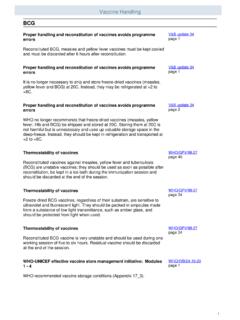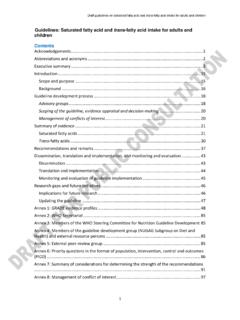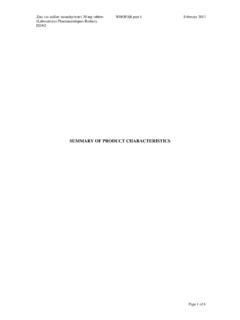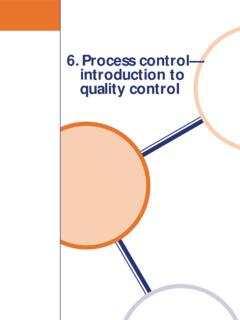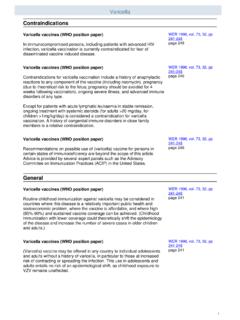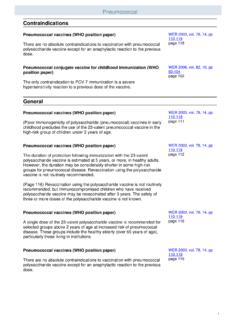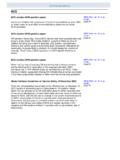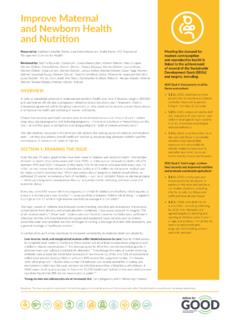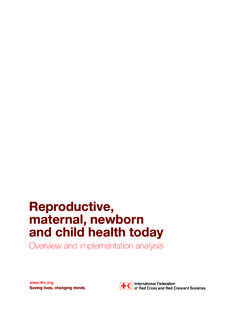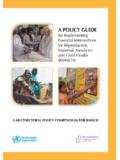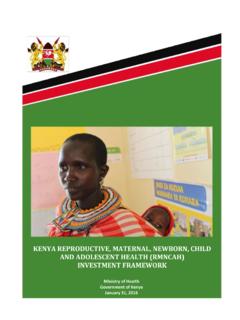Transcription of Reproductive, Newborn And Child Health Policy
1 Sierra Leone Government Ministry of Health and Sanitation reproductive , Newborn And Child Health Policy July 2011 - i - CONTENTSCONTENTSCONTENTS 1. Introduction .. 2. Situation Analysis .. 3. Guiding Principles .. 4. Vision and Mission .. 5. Goals and Objectives .. 6. Policy Statements and Areas for Action .. 7. Roles and Responsibilities of Key Stakeholders .. - 1 - ABBREVIATIONSABBREVIATIONSABBREVIATIONS AIDS Acquired Immunodeficiency Syndrome BPEHS Basic Package of Essential Health Services CRC Convention on the Rights of the Child CHP Community Health Post EPI Expanded Programme of Immunization FBO Faith Based Organisation FGM/C Female Genital Mutilation/Cutting FHCI Free Health Care Initiative FP Family Planning GoSL Government of Sierra Leone HIV Human Immunodeficiency Virus IMNCI Integrated Management of Neonatal and Child -hood Illness ITN Insecticide Treated Net MCHP maternal and Child Health Post MDAs Ministries Departments and Agencies MDGs Millennium Development Goals M&E Monitoring and Evaluation MoHS Ministry of Health and Sanitation NGO Non-Governmental Organisation NHSSP National Health Sector Strategic Plan PBF Performance Based Financing PHU Peripheral Health Unit PRSP
2 Poverty Reduction Strategy Paper RNCH reproductive , Newborn , and Child Health SGBV Sexual and Gender Based Violence SLDHS Sierra Leone Demographic Health Survey STIs Sexually Transmitted Infections UN United Nations - 2 - DEFINITIONSDEFINITIONSDEFINITIONS T he following definitions will be used by the Government of Sierra Leone (GoSL): Newborn : refers to a baby just after birth Neonate: a baby less than or equal to 28 days old Low birth weight: a baby born with a birth weight of less than 2,500 grams Infant: a baby aged between birth and less than 12 months old Child : a person aged between birth and less than 18 years Adolescent: a person aged between 10 and 19 years Youth: a person aged between 15 and 35 years Unsafe abortion: a procedure for terminating an un-wanted pregnancy performed by persons who may lack the necessary skills and/or conducted in an envi-ronment that lacks the minimal medical standards Antenatal period: time period during pregnancy from conception until delivery Postnatal period: begins immediately after the birth of the baby and extends up to six weeks after birth maternal death: a death from pregnancy-related causes Stillborn: a baby born dead after 28 weeks gestation Neonatal death: a death in the first 28 days of life Perinatal death: includes stillbirths and all neonatal deaths in the first week of life - 3 - FOREWORDFOREWORDFOREWORD T here are too many deaths of mothers, babies, and children from preventable conditions in Sierra Leone.
3 Despite recent improvements in women s and chil-dren s Health in this country, we risk of missing out on achiev-ing the Millennium Development Goals by 2015 if further in-vestments are not made. The Government of Sierra Leone recognises that many of these deaths can be prevented and many of these illnesses can be treated. It is committed to reducing maternal and in-fant mortality and morbidity, and as part of the Second Pov-erty Reduction Strategy 2008 2012 An Agenda for Change , has introduced a Basic Package of Essential Health Services, as well as the Free Health Care Initiative in a bid to improve access to healthcare for pregnant women, lactating mothers and children under the age of five. Under these poli-cies, we have already seen an increase in the utilisation of Health services.
4 To prevent malaria, one of our most preva-lent diseases, over three million long lasting insecticide treated bed nets have been distributed, with most households having received at least two bed nets. We now have the new reproductive , Newborn , and Child Health Policy 2011 2015. It recognises the Newborn , the most vulnerable member of our community, and the impor-tance of involving the whole community, including fathers, in all we do. It outlines steps to accelerate MDG progress and focuses on - 4 - Foreword equity and reducing disparities in reproductive , Newborn , and Child Health care. The Ministry of Health and Sanitation rec-ognises that reaching every woman, baby, and Child in Sierra Leone with essential, life-saving interventions, we must invest in strategic areas and work in close collaboration with our partners.
5 The Health of mothers, newborns, and children represents the well-being of all society. The Government of Sierra Leone is committed to providing an enabling environment so that this Policy can be translated into action for the development and prosperity of all Sierra Leoneans. Mrs. Zainab H Bangura HONOURABLE MINISTER OF Health AND SANITATION FREETOWN, SIERRA LEONE - 5 - T he reproductive and Child Health strategy 2008-2010 was implemented under two draft policies, the Repro-ductive Health Policy and the Child Health Policy . The two drafts have been reviewed and incorporated into one Re-productive, Newborn , and Child Health Policy that will guide implementation of the reproductive , Newborn , and Child Health Strategy 2011-2015. This would not have been possi-ble without the financial and technical support from UNICEF, UNFPA, WHO, OPTIONS, the Midwifery School, the Mid-wives Association, International Rescue Committee, PCMM, Medical Research Council, District Health Management Teams, PPASL, COMAHS, Marie Stopes Sierra Leone, Njala University, World Vision, SLMDA, Private practitioners, Health For All Coalition Sierra Leone, and the Sierra Leone Broadcasting Corporation.
6 ACKNOWLEDGEMENTSACKNOWLEDGEMENTSACKNOWLE DGEMENTS Dr. S. K. Daoh CHIEF MEDICAL OFFICER MINISTRY OF Health AND SANITATION - 6 - INTRODUCTIONINTRODUCTIONINTRODUCTION S ierra Leone has one of the highest Child and maternal mortality rates in the world. Despite recent progress, it is not on track to reach the 2015 Millennium Develop-ment Goals (MDGs) for MDG 4 and MDG 5 unless rapid ac-celeration takes place. Despite there being no specific MDG for sexual and reproductive Health , the achievement of the other MDGs, particularly 1, 3, 4, 5 and 6 which deal with nu-trition, gender equality and empowerment of women, Child mortality, maternal Health , and HIV and AIDs respectively, will have a direct or indirect impact on the reproductive Health of Sierra Leone. At the World Summit in September 2005, the Government of Sierra Leone (GoSL) recommitted itself to achieve universal access to reproductive Health by 2015 (UN2005).
7 In addition to the GoSL s commitments at the global level, the Member States of the African region adopted a regional strategy on reproductive Health in 1997. The GoSL is also a signatory to the Convention on the Rights of the Child (CRC), as well as being a signatory to the African Char-ter on the Rights and Welfare of the Child with specific tar-gets set for immunisation coverage, elimination of Vitamin A deficiency, prevention of certain vaccine preventable dis-eases, reduction in malaria mortality, scaling up of the Inte-grated Management of Neonatal and Childhood Illness (IMNCI), and the use of affordable interventions to reach every Newborn and Child in every district. The Ministry of Health and Sanitation (MoHS) has the overall responsibility for the performance of the Health sector and leads in the provision of Health care.
8 It also has the responsi-- 7 - bility for regulating, co-ordinating, monitoring and evaluating (M&E) Health care delivery in the country. The National Health Sector Strategic Plan 2010-2015 (NHSSP) has been operationalised into the Basic Package of Essential Health Services (BPEHS) for all citizens and took effect in 2010. The reproductive , Newborn , and Child Health (RNCH) section of the BPEHS contains components, interventions, and services by level of care targeting pregnant women, lactating mothers, and children aged under-five years. In order to address all components of RNCH, considerable effort needs to be made by the GoSL and its partners. The development of the Policy recognised that current community level actions are vertical and fragmented, with weak monitor-ing, supervision and oversight, and more efforts and harmoni-sation are needed at the community level.
9 To ensure demand and sustainability, all interventions should be community-owned, community-driven, and community-operated. The GoSL therefore needs to continue to provide the leadership, commitment, and the enabling environment for active com-munity participation, empowerment, and ownership in the planning and implementation of quality services that will lead to the attainment of sustainable high coverage of high impact and proven low cost RNCH interventions. In addition, Health service delivery needs strengthening. Cur-rently Health care delivery is ineffective because of limited geographical access due to inadequate numbers and inequi-table distribution of facilities; high cost of services for the ma-Introduction - 8 - jority of Sierra Leoneans (although this has changed recently with the introduction of the Free Health Care Initiative, FHCI); inadequate participation of communities in Health care deliv-ery; weak co-ordination and communication among pro-grammes and partners; limited referral systems; and a short-age of critical Health professionals (PRSPII, 2009).
10 Although free Health care is provided at the point of delivery, indirect costs, such as transport, are still required to be paid by the user. The FHCI has resulted in an initial dramatic in-crease in Health service utilisation and has shown some im-provement in certain Health outcomes. However, this initial increase in utilisation has not been sustained for many ser-vices due to quality of care issues. In addition, it has had a negative impact on the outreach programme due to the in-creased workload on limited human resources ( Health Sector Performance Review 2010). It is recognised that the Health of mothers is integrally linked to the Health of newborns, infants and children. Conse-quently, the GoSL has integrated reproductive and Child Health under one Directorate.
